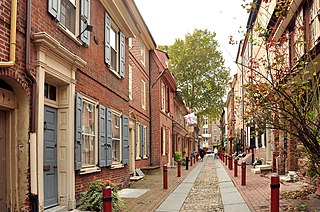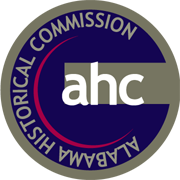Related Research Articles
The National Register of Historic Places (NRHP) is the United States federal government's official list of districts, sites, buildings, structures, and objects deemed worthy of preservation for their historical significance or "great artistic value". A property listed in the National Register, or located within a National Register Historic District, may qualify for tax incentives derived from the total value of expenses incurred in preserving the property.

The New York City Landmarks Preservation Commission (LPC) is the New York City agency charged with administering the city's Landmarks Preservation Law. The LPC is responsible for protecting New York City's architecturally, historically, and culturally significant buildings and sites by granting them landmark or historic district status, and regulating them after designation. It is the largest municipal preservation agency in the nation. As of July 1, 2020, the LPC has designated more than 37,800 landmark properties in all five boroughs. Most of these are concentrated in historic districts, although there are over a thousand individual landmarks, as well as numerous interior and scenic landmarks.

The National Historic Preservation Act is legislation intended to preserve historic and archaeological sites in the United States of America. The act created the National Register of Historic Places, the list of National Historic Landmarks, and the State Historic Preservation Offices.

Historic districts in the United States are designated historic districts recognizing a group of buildings, archaeological resources, or other properties as historically or architecturally significant. Buildings, structures, objects, and sites within a historic district are normally divided into two categories, contributing and non-contributing. Districts vary greatly in size and composition: a historic district could comprise an entire neighborhood with hundreds of buildings, or a smaller area with just one or a few resources.

In the law regulating historic districts in the United States, a contributing property or contributing resource is any building, object, or structure which adds to the historical integrity or architectural qualities that make the historic district significant. Government agencies, at the state, national, and local level in the United States, have differing definitions of what constitutes a contributing property but there are common characteristics. Local laws often regulate the changes that can be made to contributing structures within designated historic districts. The first local ordinances dealing with the alteration of buildings within historic districts was enacted in Charleston, South Carolina in 1931.

The U.S. Commission of Fine Arts (CFA) is an independent agency of the federal government of the United States, and was established in 1910. The CFA has review authority over the "design and aesthetics" of all construction within Washington, D.C. In accordance with the Old Georgetown Act, the CFA appoints the Old Georgetown Board. The Old Georgetown Board has design review authority over all semipublic and private structures within the boundaries of the Georgetown Historic District. The CFA was granted approval authority by the Shipstead-Luce Act over the design and height of public and private buildings which front or abut the grounds of the United States Capitol, the grounds of the White House, Pennsylvania Avenue NW extending from the Capitol to the White House, Lafayette Square, Rock Creek Park, the National Zoological Park, the Rock Creek and Potomac Parkway, Potomac Park, and the National Mall and its constituent parks.
The Philadelphia Register of Historic Places (PRHP) is a register of historic places by the Philadelphia Historical Commission. Buildings, structures, sites, objects, interiors and districts can be added to the list.

The Alabama Historical Commission is the historic preservation agency for the U.S. state of Alabama. The agency was created by an act of the state legislature in 1966 with a mission of safeguarding Alabama's historic buildings and sites. It consists of twenty members appointed by the state governor or who serve in an official position. The members represent a broad cross section of Alabamians including architects, historians, archaeologists, and representatives of state universities. The commission is tasked with acquisition and preservation of historic properties and education of the public about historic sites in Alabama.
The City of Omaha Landmarks Heritage Preservation Commission, established in 1977, is the Omaha city government's a nine-member board responsible for recommending official Omaha Landmarks to the Omaha City Council. The Landmarks Heritage Preservation Commission is that was established by ordinance in 1977 to review and recommend to the City Council on all matters pertaining to the designation of individual buildings, sites, objects, or entire districts of local historical significance. The commission is staffed by the Landmarks Division of the Omaha Planning Department.

Prairie Avenue is a north–south street on the South Side of Chicago, which historically extended from 16th Street in the Near South Side to the city's southern limits and beyond. The street has a rich history from its origins as a major trail for horseback riders and carriages. During the last three decades of the 19th century, a six-block section of the street served as the residence of many of Chicago's elite families and an additional four-block section was also known for grand homes. The upper six-block section includes part of the historic Prairie Avenue District, which was declared a Chicago Landmark and added to the National Register of Historic Places.

This is a list of the Davenport Register of Historic Properties in Davenport, Iowa, United States.
New Rochelle Historic Site is a designation of the Historical and Landmarks Review Board (HLRB), for buildings, structures, monuments and other historically significant properties in the city of New Rochelle in Westchester County, New York. Significant sites are chosen after meeting a combination of criteria, including historical, economic, architectural, artistic, cultural, and social values.

The Dr. Philip Weintraub House is an early modern single-family house in the Hollywood Park neighborhood of Chicago, Illinois. Located at 3252 W. Victoria Street, the home was built in 1940 by architect Andrew Nicholas Rebori (1886-1966) and artist Edgar Miller (1899-1993) for Philip Weintraub.
The City of Seattle Landmarks Preservation Board is responsible for designating and preserving structures of historical importance in Seattle, Washington. The board recommends actions to the Seattle City Council, which fashions these into city ordinances with the force of law. The board is part of the city's Department of Neighborhoods.
The District of Columbia Inventory of Historic Sites is a register of historic places in Washington, D.C. that are designated by the District of Columbia Historic Preservation Review Board (HPRB), a component of the District of Columbia Government.
The Columbus Register of Historic Properties is a register for historic buildings and other sites in Columbus, Ohio, United States. The register is maintained by the City of Columbus Historic Resources Commission and Historic Preservation Office, and was established in 1980. Many of these landmarks are also listed on the National Register of Historic Places, providing federal tax support for preservation, and some are further designated National Historic Landmarks, providing additional federal oversight.

Baltimore City Landmark is a historic property designation made by the city of Baltimore, Maryland. Nominations are reviewed by the city's Commission for Historical & Architectural Preservation (CHAP) and planning board, and are passed by Baltimore City Council. The landmarks program was created in 1971.
References
- ↑ Ballew, Jonathan (Nov 1, 2019). "From Masonic Lodge to Buddhist Temple". block club chicago. Retrieved 2022-07-25.
Commission on Chicago Landmarks